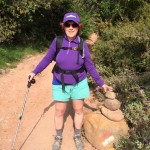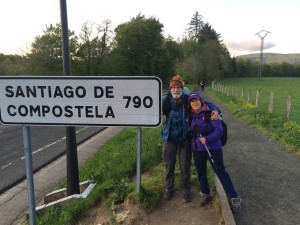I don’t think the word “hiking” ever entered into my vocabulary, even in my teenage and college years, much less “backpacking.” I am eternally grateful to my boyfriend in 1970, when I was 22, who turned me on to that wonderful sport. I got hooked then and still am! Hanging out in nature’s paradise amidst breathtaking mountains, lakes, forests, streams. Away from cities, traffic, pollution, and most other humans. And, other than the gear and perhaps a parking pass, it’s absolutely free.
Then: When I moved to Seattle in 1973, I found a backpacker’s paradise discovered by very few people. Ridges with awesome views of snow-covered peaks overlooking crystalline jade lakes were my favorite. And they still are. No one purified water back then and no one got Giardia. I didn’t buy my first water filter until years later.
But back then I carried 45+ pounds including wool knickers, heavy wool knee socks, heavy cooking gear, an aluminum frame pack, and regular-weight down sleeping bag and tent, and a trusty Thermarest. Blisters on my feet were inevitable until I discovered a size-too-large Mephisto hiking boots (now I prefer low Salomons). And I’ll never forget how incredibly sore my shoulders were every day despite my makeshift padding under the shoulder straps.
Now: Happily, all of that has changed. I can thank a patient of mine who introduced me, ten years ago, to the concept of ultra-light gear. Last weekend I carried 23# for 4 days and Bob 27#! Including water. What a relief! I feel so sorry for the hikers who carrying enormous, ridiculously heavy packs. We even ran into a guy last weekend at Mt. Baker on the Skyline Divide Trail who was carrying who knows how many pounds of beer cans!
You can find lots of info about how to pack ultra-light online, but let me give you some tips. Now that I’m 70 and not 22, this is how Bob and I can keep venturing into the backcountry, to the amazement of many of our friends who are replacing hips, knees, and would struggle with a steep walk of more than a couple of miles. Take it from a couple of seniors who hope to hike past 80. Like a friend of ours who just turned 90, Meg Peterson, who is heading to the Annapurna Range in Nepal this December.
Pack: We swear by our Gossamer Gear packs which look like nothing but grey lightweight fabric with black mesh pockets, weigh under 2 pounds, and are remarkably comfy. We added a very lightweight inflatable pad that goes between our backs and the water bladders. And, of course, light hiking poles. I just bought Black Diamond Women’s Distance Flz. Very high tech and collapse to 13”!
Sleeping gear: Our Big Agnes sleeping bags are normal down on the top but the bottom is just a sleeve into which we slide our Thermarest Neo-Air pads. We don’t like mummy bags. They feel too claustrophobic. These pads truly feel like sleeping on a cloud. Our Exped inflatable pillows slip into miniature stuff sacks. We put our sleeping gear and clothes in a garbage bag and take an extra.
Tent: Our newest addition is our 4# MSR Hubba Hubba 2-person tent. It is airy and light, but we just spent a chilly night amidst tarns and ice patches at Yellow Aster Butte in the Mt. Baker Wilderness and we stayed warm.
Clothing: It’s all about layers. Patagonia jacket, lightweight vest, Marmot ultra-light wind/rain jacket, Patagonia rain pants, polar guard hat and gloves.
My zip-off pants that I had since 1970 were so paper thin that they ended up in a garbage can in the Madrid airport this spring. So I take one pair of shorts, Polarguard fleece pants, a couple pairs of light Merino socks, Salomon Women’s GT-Ex hiking boots (a previous pair got me through 500 miles of the Camino de Santiago de Compostela), a couple of pairs of Ex Officio light underpants, 2-3 sleeveless tops, a long-sleeve shirt I’ve had for 30+ years, and a long-sleeve Merino shirt when needed. Long underwear is handy for sleeping or extra cold weather. I also take a pair of Crocs.
Food: We’ve given up on complex dinners. We take a Jet Boil (with fuel canister) to heat water to add for dinners, Potholder and scrubber. Titanium cup (we didn’t use this last time). Best is to pre-make your fave dinner then dehydrate. Breakfasts are the heaviest: granola with freeze-dried berries and rehydrated coconut milk powder. Trader Joe’s has great lunch options: organic jerky, crackers, and dehydrated beets, broccoli, and mango. We left our nuts, dried fruit, and cheese at home this last time. (Plus some protein bars. Lately we buy the TJ’s RX brand.) We fill the CamelBak water bladder with 1.5 liters of water for each day.
Other: Waterproof pack covers, a map, compass, whistle, stuff sack to hang food at night, emergency black in case, our 50-remedy homeopathic remedy kit (along with our book The Savvy Traveler’s Guide, which we don’t need since we wrote it), Calendula cream, deodorant, mini-travel comb with mirror, Steripen to purify water via UV light (and extra lithium battery), extra Nalgene water bottle to pour in the water, lightweight nylon towel, tiny container Dr. Bronner’s liquid soap, mini-toothbrush, toothpaste, floss, LED headlamp, Spot Satellite emergency locator device, iPhone for photos, blister pads/Second Skin, waterproof matches. I do a mini-bath and wash my hair every day (ice cold stream water), and 2 Ziploc bags work, one for clean water and one for soapy. Small piece of paper and pen.
I’m sure I forgot something, but not much. We did each take a small paperback book. You could take mini travel Scrabble or binocs.
For those of you who would love to backpack but not carrying half your weight (!), I hope this opens up your world to new vistas with less pain and lots more fun!



Recent Comments